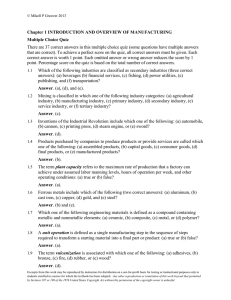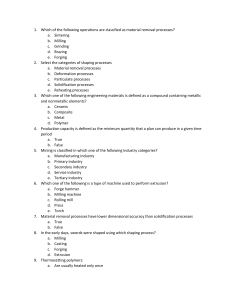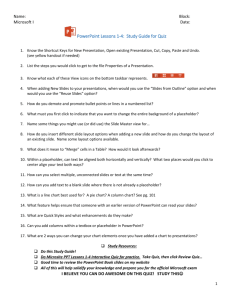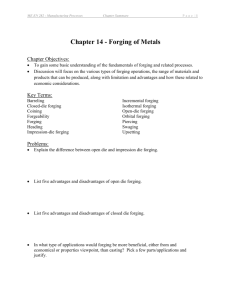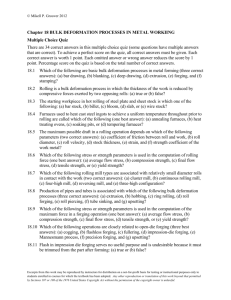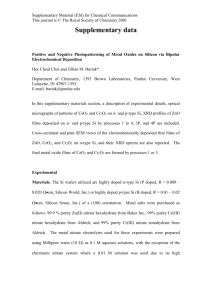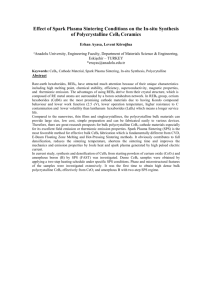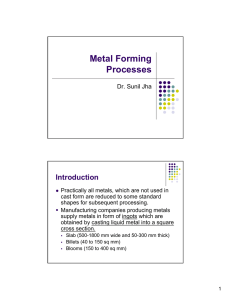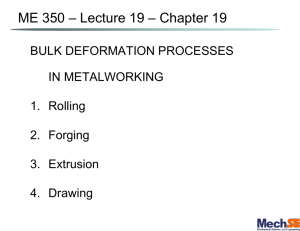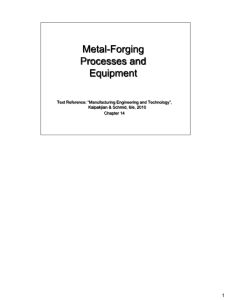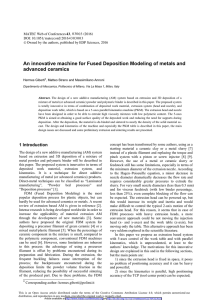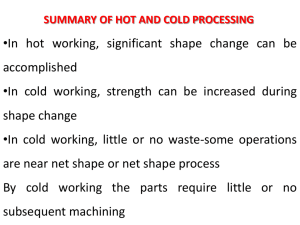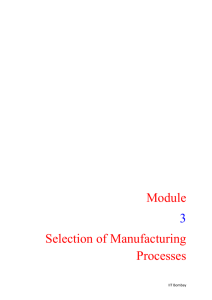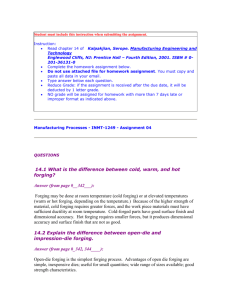Mikell P Groover 2012 Chapter 1 INTRODUCTION AND OVERVIEW
advertisement
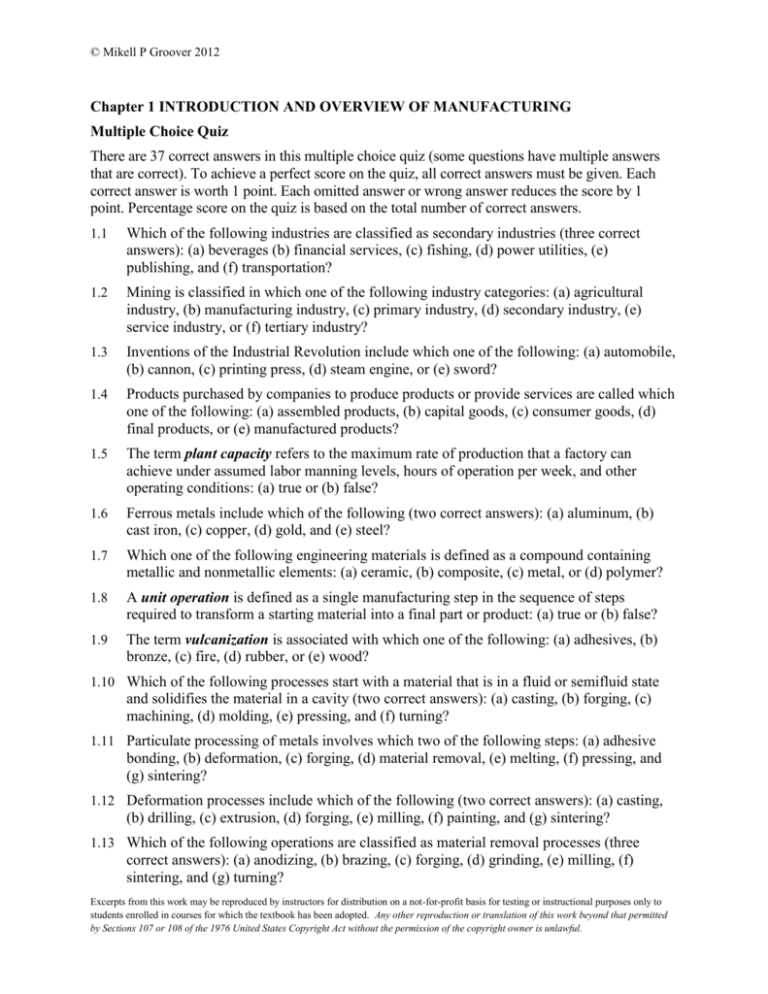
© Mikell P Groover 2012 Chapter 1 INTRODUCTION AND OVERVIEW OF MANUFACTURING Multiple Choice Quiz There are 37 correct answers in this multiple choice quiz (some questions have multiple answers that are correct). To achieve a perfect score on the quiz, all correct answers must be given. Each correct answer is worth 1 point. Each omitted answer or wrong answer reduces the score by 1 point. Percentage score on the quiz is based on the total number of correct answers. 1.1 Which of the following industries are classified as secondary industries (three correct answers): (a) beverages (b) financial services, (c) fishing, (d) power utilities, (e) publishing, and (f) transportation? 1.2 Mining is classified in which one of the following industry categories: (a) agricultural industry, (b) manufacturing industry, (c) primary industry, (d) secondary industry, (e) service industry, or (f) tertiary industry? 1.3 Inventions of the Industrial Revolution include which one of the following: (a) automobile, (b) cannon, (c) printing press, (d) steam engine, or (e) sword? 1.4 Products purchased by companies to produce products or provide services are called which one of the following: (a) assembled products, (b) capital goods, (c) consumer goods, (d) final products, or (e) manufactured products? 1.5 The term plant capacity refers to the maximum rate of production that a factory can achieve under assumed labor manning levels, hours of operation per week, and other operating conditions: (a) true or (b) false? 1.6 Ferrous metals include which of the following (two correct answers): (a) aluminum, (b) cast iron, (c) copper, (d) gold, and (e) steel? 1.7 Which one of the following engineering materials is defined as a compound containing metallic and nonmetallic elements: (a) ceramic, (b) composite, (c) metal, or (d) polymer? 1.8 A unit operation is defined as a single manufacturing step in the sequence of steps required to transform a starting material into a final part or product: (a) true or (b) false? 1.9 The term vulcanization is associated with which one of the following: (a) adhesives, (b) bronze, (c) fire, (d) rubber, or (e) wood? 1.10 Which of the following processes start with a material that is in a fluid or semifluid state and solidifies the material in a cavity (two correct answers): (a) casting, (b) forging, (c) machining, (d) molding, (e) pressing, and (f) turning? 1.11 Particulate processing of metals involves which two of the following steps: (a) adhesive bonding, (b) deformation, (c) forging, (d) material removal, (e) melting, (f) pressing, and (g) sintering? 1.12 Deformation processes include which of the following (two correct answers): (a) casting, (b) drilling, (c) extrusion, (d) forging, (e) milling, (f) painting, and (g) sintering? 1.13 Which of the following operations are classified as material removal processes (three correct answers): (a) anodizing, (b) brazing, (c) forging, (d) grinding, (e) milling, (f) sintering, and (g) turning? Excerpts from this work may be reproduced by instructors for distribution on a not-for-profit basis for testing or instructional purposes only to students enrolled in courses for which the textbook has been adopted. Any other reproduction or translation of this work beyond that permitted by Sections 107 or 108 of the 1976 United States Copyright Act without the permission of the copyright owner is unlawful. © Mikell P Groover 2012 1.14 Which of the following are referred to as thin film deposition processes (two correct answers): (a) chemical vapor deposition, (b) electroplating, (c) extrusion, (d) painting, and (e) physical vapor deposition? 1.15 Which one of the following is a type of machine used to perform extrusion: (a) forge hammer, (b) milling machine, (c) rolling mill, (d) press, or (e) torch? 1.16 Which of the following features and terms are associated with batch production: (a) cellular manufacturing, (b) mass production, (c) medium quantity production, (d) production equipment is dedicated to one product, and (e) setup time between batches is a disadvantage? 1.17 High-volume production of assembled products is most closely associated with which one of the following layout types: (a) cellular layout, (b) fixed position layout, (c) process layout, or (d) product layout? 1.18 A production planning and control department accomplishes which of the following functions in its role of providing manufacturing support (two best answers): (a) designs and orders machine tools, (b) develops corporate strategic plans, (c) orders materials and purchased parts, (d) performs quality inspections, and (e) schedules the order of products on a machine? 1.19 A typical production cycle time consists of which of the following elements (three best answers): (a) actual processing time, (b) inspection time, (c) rest breaks for the worker, (d) time to withdraw starting materials from storage, (e) tool fabrication time, (f) tool handling time, and (g) work handling time? 1.20 Which of the following cost categories are considered to be variable costs rather than fixed costs (two correct answers): (a) direct labor, (b) equipment, (c) insurance, (d) maintenance, (e) work material, and (f) research and development? 1.21 A product’s total manufacturing costs typically constitute what proportion of the product’s selling price: (a) 10%, (b) 20%, (c) 40%, (d) 60%, or (e) 80%? 1.22 In the context of production equipment in a factory, the term availability is best defined by which one of the following: (a) downtime proportion, (b) hourly operating cost, (c) proportion of good products, (d) proportion uptime, or (e) utilization? 1.23 One of the first applications of digital computers in manufacturing was direct numerical control, which is best described by which one of the following: (a) computers used to count work units on a production line, (b) flexible manufacturing, (c) mainframe computers used to remotely control machine tools in a factory, (d) personal computers used to schedule production, or (e) shop floor control? Excerpts from this work may be reproduced by instructors for distribution on a not-for-profit basis for testing or instructional purposes only to students enrolled in courses for which the textbook has been adopted. Any other reproduction or translation of this work beyond that permitted by Sections 107 or 108 of the 1976 United States Copyright Act without the permission of the copyright owner is unlawful.
